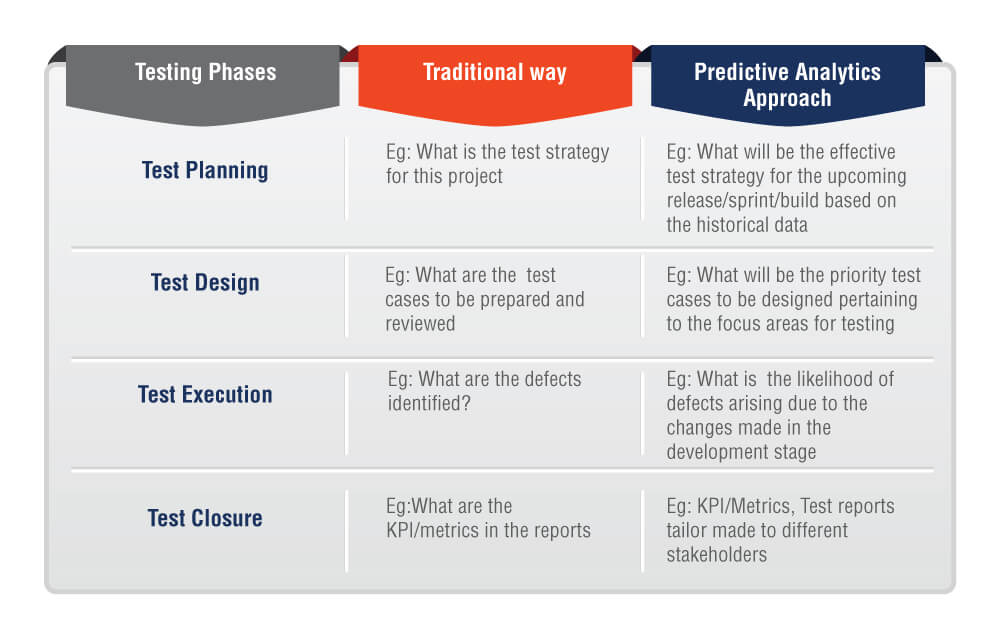This website uses cookies. By continuing to browse the site, you are agreeing to our use of cookies
‘Prediction is Power’ – A Predictive Insight to Software Testing
Testing
November 15, 2016
The ability to predict the future has always captivated human minds. No wonder Predictive Analytics has become “open sesame” of our digital world. Ever wondered the implication of analytics in our daily life or rather name it as a ‘data driven ‘life. Be it the google search which provides a drop down list once you start typing, the obsessive shopping experience you encounter due to smart work of e-commerce sites or the Facebook news feed which prioritizes your updates based on who you connect more frequently with – everything has been carved out with perfection with the help of analytics.
Well, what is Predictive analytics? It is a “technology that learns from experience (data) to predict the future behavior of individuals in order to drive better decisions.” (Source: Eric Siegel-Predictive analytics: The power to predict who will click, buy, lie or die.). This clearly indicates the fact that data is the key. For those of you, who have watched the Money ball movie would appreciate the connotation “data” holds. The plot is about how Oakland Athletics general manager Billy Beane is upset by his team’s loss in the 2001 post season and takes the help of an economist Peter who uses predictive analytics to analyze and place the value on the players to be picked for the team. In the end, the low budget team so formed wins 20 consecutive games setting the American league record. Well, what’s noteworthy is the sabermetric approach (Empirical analysis of baseball statistics that measure in-game activity) which Peter uses, to carve out the championship team. Rather than using the traditional methods of evaluation (experience, intuition), the key metric (On base percentage) is used to select the players.
So what’s the takeaway for software testing? Well, it is about using a money ball approach to our projects; be it identifying the right tester/testing team that is best suited to deliver the project, proactively identifying the defects that are likely to arise and mitigating them at an earlier stage, identifying and prioritizing the critical test cases or identifying the hotspots that affect the testing progress and on-time delivery. In gist, the following key tenets for a project can be addressed using predictive analytics to ensure efficiency in testing operations.
-
- Cost- Eg :Identifying the defects likely to arise and mitigating them at an earlier stage
- Quality- Eg: Identifying the right tester/testing team to deliver the project
- Time- Eg: Predictive based planning by foreseeing the impediments that might affect the deadline
According to the world quality report 2015-16, one of the leading challenges in the ultra-short development cycles is the inability to decide on what to test and what not to. But with predictive analytics as a key solution, the testing team will be able to have an insight on the impact of changes made in the development stage across the entire SDLC and thereby identifying the testing needs to produce the minimum viable product.
The below table encapsulates the sample questions that will be answered in the traditional way and using predictive analytics approach.

A survey in the world quality report 2015-16 indicates the top three sectors which has predictive analytics specialists in their testing organizations-Public sector (70%), automotive (66%) and Energy & utilities (64%).With the growing need of analytics in every sector, there are many predictive analytics solution providers in the market these days to provide the relevant tools which throws light on the different data points that are ignored by the human eye for creation of a predictive model. The point to be noted is that a predictive analytics” solution doesn’t work like a crystal ball. “Rich Data” is the key as the recommendations from the analysis stand valid depending on the quality of data.
Well, the application of predictive analytics in testing will foster many benefits – faster time to market, ensuring quality in delivery and using the right skill set to achieve the goal. As quoted in the moneyball movie “Business is like baseball, in that there are finite, measurable business parameters that make great candidates to apply analytics to and derive insights not readily apparent.” If we understand the need in the software testing space, gather the “right” data and apply analytics, useful insights for delivering better quality can be achieved.
Related Blogs

Transformative Impact of Generative AI on the Autonomous Testing Landscape
- Testing
- Generative AI

Leveraging ChatGPT for Effective Software Testing: Opportunities and Challenges
- Testing
- Generative AI

Ready to Pursue Opportunity?
Every outcome starts with a conversation















